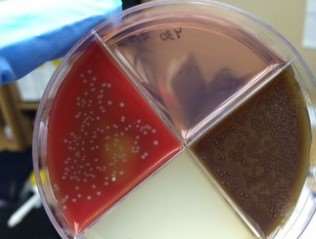By Ginger D Fenton, PhD

New ways to incorporate on-farm culturing in herd health routines.
The notion of using on-farm culturing to gain more information about the causes of mastitis and to make subsequent treatment decisions based on these results has been around for a while. There are several systems or types of agar plates that can be used to aid in determining the organism that is responsible for mastitis. Culturing on the farm is relatively easy following some instruction. Aside from the initial purchase of an incubator, which can vary greatly in price, culturing can help producers realize savings due to more judicious use of treatments, less milk lost, a reduction in unnecessary culling, and improved milk quality. However, most producers may not have considered other applications of culturing on their farm beyond mastitis.
Another possible application of on-farm culturing involves a periodic check on the effectiveness of the farm’s pasteurizer for waste milk fed to calves. This milk likely has been withheld from the tank for reasons such as a high bacteria load or the presence of pathogens that may be harmful to calves. A quality check of the pasteurizer should be conducted on a routine basis, which may be weekly on large farms or more frequently if needed. Samples should be collected and cultured prior to pasteurization, after the waste milk has been pasteurized, and at the point where it will be fed to the calves. Standard plate count (SPC) and coliform count are appropriate tests. Agar plates or commercial products such as Petrifilm™ can be used.
More recently, another potential application of on-farm culturing was described in a study from Canada (Dubuc, 2017). The purpose of this study was to determine whether Escherichia coli was present in the uterus of the cows and also to track the occurrence of puerperal metritis in cows that were positive for the bacterium. The author’s rationale for the study was that the presence of E. coli in the uterus at the time of sampling is a risk factor for puerperal metritis. When selecting farms for the study, previous experience using culturing as a herd health tool was considered.
In this study, uterine swabs were collected in triplicate from 400 cows between 24 and 48 hours post-calving. For each set, one sample was processed in a veterinary diagnostic laboratory while the other sets were processed on the participating farms. The two culturing systems used at the farms included the Tri-plate system from the University of Minnesota and coliform Petrifilm™. The Tri-plate system utilizes three types of media including MacConkey agar to select for Gram-negative microorganisms, Factor media for Gram-positive microorganisms, and Modified TKT media to select for Strep. and Strep-like microorganisms. Petrifilm™ is hydrated by the sample prior to incubation, therefore the swabs used with the Petrifilm™ were submerged into 1 mL of sterile water and shaken to transfer the microorganisms to the water, which was then placed onto the Petrifilm™.
In a method similar to on-farm culturing for mastitis pathogens, the plates and Petrifilm™ were incubated in an egg incubator at 37°C for 48 hours. The results from both of the on-farm methods were comparable to the tests performed in the laboratory. Bear in mind that these on-farm tests are used to determine the presence or absence of the specified microorganisms and are not focused on determining a bacteria count. In the future, producers may see the on-farm applications of culturing grow as more possibilities exist for incorporating this practice into their herd health routines and researchers continue to explore practical approaches to implementing microbiological tests.
Source: psu.edu